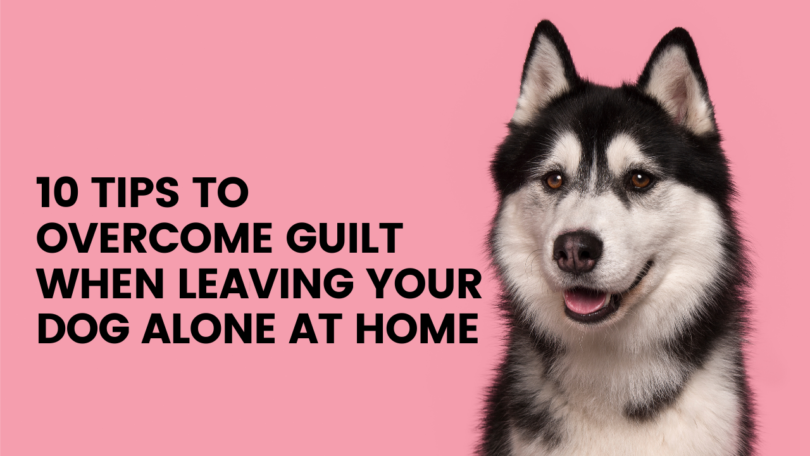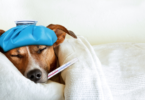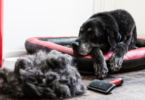Ah, the dreaded moment when you have to leave your furry best friend behind as you head out the door. Those big puppy eyes, that mournful whimper – it's enough to make even the toughest dog parent feel like they're abandoning their child. But fear not, fellow guilt-ridden dog lovers! We're about to embark on a journey through ten tried-and-true tips to help you overcome that nagging guilt and ensure your pup is living their best life, even when you're not around. So grab a treat (for you and your dog), and let's dive in!
1. The Great Escape Artist: Mastering the Art of the Low-Key Exit
You know that heart-wrenching scene in every rom-com where one person dramatically chases after the other at the airport? Yeah, your dog thinks that's how you should say goodbye every time you leave the house. But here's the secret: make your departures as boring as watching paint dry.
Try this:
– Start your leaving routine (grabbing keys, putting on shoes) but don't actually leave.
– Repeat this several times a day until your dog yawns at your “performance.”
– When you do leave, keep it casual. No long goodbyes or Oscar-worthy speeches.
One reformed drama queen dog owner shared, “I used to give my Lab a 5-minute monologue every time I left. Now I just say ‘See ya' like I'm popping out for milk. He's gone from howling Shakespearean sonnets to barely lifting his head from his bed when I leave.”
Remember, your calm energy will help your dog stay calm. It's like a Jedi mind trick, but for pets!
2. The Puzzle Master: Keeping That Doggy Brain Busy
Ever heard the saying “an idle paw is the devil's workshop”? Okay, maybe we just made that up, but the principle stands! A bored dog is more likely to focus on your absence and spiral into anxiety. Enter: puzzle toys, the doggy equivalent of giving your kid an iPad on a long car ride.
Try these brain-busters:
– Kong toys filled with frozen peanut butter (a classic for a reason)
– Snuffle mats for the canine treasure hunters
– Treat-dispensing balls for the sporty types
– Hide treats around the house for a doggy scavenger hunt
One clever dog mom reported, “I got my Border Collie a puzzle toy that's harder than my Sudoku. He's so busy trying to get the treats out, he doesn't even notice I'm gone. I'm pretty sure he's going to solve world hunger next.”
Pro tip: Rotate the toys to keep things interesting. It's like Netflix, but for dogs!
3. The Soundtrack of Solitude: Calming Tunes for Canine Ears
Who knew your dog had such refined musical tastes? Turns out, the right tunes can turn your anxious Alfie into a zen master. And no, we're not talking about your old college mixtapes (though that might work too, if only to make your dog glad you're gone).
Some paw-tapping options:
– Classical music (Bach, not Beethoven – we don't need any more howling)
– Specially composed dog music (yes, it's a thing)
– Nature sounds (because every dog dreams of being a wolf, right?)
– Audiobooks (for the literary pooches)
One music-loving Mastiff owner shared, “I left my playlist on by accident one day. Came home to find my dog chillin' like a villain to some smooth jazz. Now he gives me the stink eye if I don't put on his ‘jam' before I leave.”
Just remember, no heavy metal or techno – we're aiming for calm, not a doggy rave party!
4. The Scent of You: Leaving Your Essence Behind
No, we're not suggesting you stop doing laundry (though that might work too). We're talking about leaving something that smells like you to comfort your pup. It's like those long-distance relationship t-shirt swaps, but less creepy and more furry.
Scent-sational ideas:
– An unwashed t-shirt (your dog loves you, stink and all)
– A blanket you've used
– A toy you've handled extensively
– A pillowcase from your bed
One sentimental Schnauzer parent confessed, “I left my old sweater for my dog. Came home to find him wearing it like a cape. I'm not sure if he misses me or is planning to become a doggy superhero in my absence.”
Just make sure whatever you leave isn't something your dog might destroy. We're going for comfort, not a CSI crime scene recreation.
5. The Workout Wonder: Tire Them Out Before You Head Out
Ever tried to be anxious while exhausted? It's like trying to run a marathon after Thanksgiving dinner – nearly impossible. The same goes for your dog. A tired dog is a good dog, and more importantly, a dog too pooped to panic.
Energy-zapping activities:
– A long walk or jog (bonus: you get fit too!)
– A game of fetch (with a ball launcher if you value your rotator cuff)
– Doggy playdates (social skills and exercise – two birds, one stone!)
– Agility training (turn your backyard into a canine obstacle course)
One fitness-loving Frenchie owner boasted, “I take my dog for a run every morning. By the time I leave for work, he's too tired to even lift his head off the pillow. I'm pretty sure he's relieved when I go so he can nap in peace.”
Remember, a physically tired dog is a mentally calm dog. It's like doggy meditation, but with more panting.
6. The Gradual Goodbye: Baby Steps to Independence
Rome wasn't built in a day, and your dog won't overcome separation anxiety overnight. But with patience and practice, you can help your pup build up their alone-time tolerance like a muscle.
The step-by-step approach:
– Start with super short absences (we're talking seconds here)
– Gradually increase the time you're gone
– Mix it up – sometimes be gone for 5 minutes, sometimes for 30
– Practice weekend absences too (because your dog needs to know you'll come back on Saturdays as well)
One patient Poodle parent shared, “We started with me just stepping outside for 10 seconds. Now I can go to the grocery store without coming home to a doggy meltdown. It's like training for the separation anxiety Olympics, and we're going for gold!”
Remember, consistency is key. It's like learning a new language – regular practice makes perfect.
7. The Canine Cam: Keeping an Eye on Your Furry Friend
Welcome to the 21st century, where you can check in on your dog from anywhere in the world. It's like having a nanny cam, but for your fur baby. Plus, it's a great way to catch them doing all the things they pretend not to do when you're home.
Tech-savvy tips:
– Set up a pet camera with two-way audio (for those pep talks)
– Use treat-dispensing cameras for positive reinforcement
– Don't overdo it – constant checking can make you both anxious
– Share access with family members for extra peace of mind
One tech-loving Terrier owner admitted, “I got a pet cam to ease my anxiety about leaving my dog. Turns out, he spends most of his time sleeping on my pillow and watching squirrel TV through the window. I'm not sure who this camera was really for anymore.”
Just remember, what happens on the pet cam stays on the pet cam. No judging if you catch your pup having a solo dance party!
8. The Comfort Zone: Creating a Safe Space
Every dog needs their own little fortress of solitude, a place where they feel safe and secure. It's like their own personal man-cave or she-shed, but with more fur and slobber.
Cozy corner ideas:
– A crate with comfy bedding (if your dog is crate trained)
– A designated room with familiar toys and bedding
– A quiet corner with a bed and some white noise
– A spot with a view of the outside world (for the nosy neighbors)
One creative Corgi owner shared, “I turned our spare closet into a doggy den. It's got fairy lights, a memory foam bed, and a white noise machine. I'm pretty sure my dog now lives better than I do.”
The key is to make this space a positive place, not a punishment zone. Think of it as a five-star hotel for your four-legged friend.
9. The Routine Revolution: Consistency is Key
Dogs thrive on routine. It's like they have an internal clock, but instead of hours and minutes, it runs on walks and meal times. Establishing a consistent routine can help your dog feel secure, even when you're not there.
Routine rituals:
– Set regular meal times (and stick to them)
– Schedule walks at the same time each day
– Create a bedtime routine (yes, even for dogs)
– Have a consistent morning routine before you leave
One organized Otterhound owner shared, “Our morning routine is so consistent that my dog now gives me the side-eye if I'm running late. He's better than any alarm clock I've ever had!”
Remember, a predictable routine helps your dog understand that yes, you leave, but you always come back. It's like a daily promise to your pup.
10. The Guilt-Free Getaway: Taking Care of You
Here's a revolutionary idea: taking care of yourself actually helps your dog! When you're relaxed and happy, your dog picks up on that energy. So don't feel guilty about taking that yoga class or meeting friends for dinner. Your mental health matters too!
Self-care strategies:
– Schedule regular “me time” activities
– Plan outings with friends or family
– Take up a hobby that gets you out of the house
– Remember that a happy owner means a happy dog
One guilt-free Golden Retriever owner confessed, “I used to feel so bad about leaving my dog that I never went out. Now I realize that taking care of myself makes me a better dog parent. Plus, I think my dog enjoys the break from my constant attention!”
Remember, your dog wants you to be happy. They're not sitting at home plotting revenge for your absence (well, most of them aren't, anyway).
Bonus Tip: The Professional Touch
Sometimes, despite our best efforts, we need a little extra help. Don't be afraid to call in the professionals if you're really struggling with guilt or if your dog is showing signs of severe separation anxiety.
Professional options:
– Consult with a dog behaviorist
– Consider doggy daycare for socialization
– Hire a dog walker for midday breaks
– Talk to your vet about anxiety medications if needed
One grateful Greyhound guardian shared, “We finally consulted a behaviorist after months of struggling with leaving our dog alone. It turns out, our approach was all wrong for our dog's personality. With professional help, we made more progress in two weeks than we had in six months on our own.”
Remember, seeking help isn't a sign of failure – it's a sign that you're a dedicated, responsible pet parent who wants the best for your furry friend.
In the end, overcoming guilt when leaving your dog alone is as much about training yourself as it is about training your dog. It's about finding that balance between being a loving, attentive pet parent and maintaining your own life and independence. Your dog doesn't want you to feel guilty – they just want you to come home and give them belly rubs (and maybe a treat or two).
So the next time you're heading out the door and those puppy dog eyes start to make you feel like the worst person in the world, remember these tips. Take a deep breath, give your pup a casual “See ya later,” and know that you're doing your best. And who knows? Your dog might just be planning an epic sock-chewing party for while you're gone. After all, what happens when the humans are away, stays between the dogs!











Leave a Comment